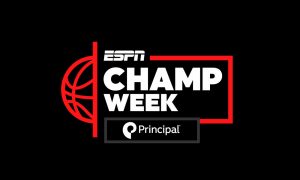With 180 Games in 12 Days, Champ Week Tests ESPN’s Production, Operational Versatility
An array of production styles will be deployed to meet programming plans
Story Highlights
Few points on the ESPN calendar get busier – and more thrilling — than Championship Week, the pre-March Madness series of conference tournaments.
Covering both men’s and women’s college basketball, the ESPN family will broadcast 180 games spanning 32 tournaments (including 24 conference title games) during the span of just 12 days.
 How in the world do they do it? As with anything that happens in sports-video production on a grand scale: with a lot of planning and collaboration.
How in the world do they do it? As with anything that happens in sports-video production on a grand scale: with a lot of planning and collaboration.
Champ Week truly tests the range of capabilities of the network’s basketball coverage featuring everything from the biggest productions featuring all the high-end toys, such as in-arena Spidercams at professional venues, to at-home (REMI) productions out of small mid-major gyms. According to Erin Orr, remote operations manager, ESPN, 15 tournaments will be full-fledged onsite ESPN productions, seven will be covered via at-home production workflows, and 10 will be handled by third-party packagers.
When it comes to deploying specialty production tools, the Power 6 conferences will receive the most love. The SEC men’s and women’s tournaments will have onsite studio coverage, aerial cameras (Spidercam at men’s, Supracam at women’s), and added behind-the-scenes, all-access shoots. There will also be onsite studios at the ACC and Big 12 men’s tournaments, with ACC getting a Spidercam.
The Power 6 coverage will also feature what ESPN calls REMNAS (Remote Near Access Storage) for file transfer. It allows postgame press conferences and melts to be sent to both Charlotte, NC, and Bristol, CT, facilities in a quick, file-based fashion. Orr says REMNAS “is helping aid the edit process not just onsite but back in Bristol and Charlotte.”
Every night, feeds are archived directly to Bristol, and using this system and essentially linking Charlotte, Bristol, and all the sites enables information to be passed around quickly. It proves tremendously helpful for personnel working onsite, and they no longer need to stay late following a broadcast day to send melts to the mothership. That work can now be uploaded to staff back home.
The graphics of ESPN’s college-basketball property are also receiving a refresh this week. Additional flare for the current package will be weaved in to enhance the magnitude and gravity of the games. ESPN makes it a point to use this variation of its college-hoops graphics package only during Champ Week to add to its special and rare feel. In addition, ESPN’s ART and Stats systems will be on many sites, adding enhanced statistical information to feed those graphics.
When it comes to logistics, mid-major conferences present some of the greatest challenges, according to Orr. Top seeds serve as the host in many instances. In fact, tournaments like the America East (men’s and women’s), Atlantic Sun (men), Big South (men), and NEC (men’s and women’s) can have a turnaround time of just 48-72 hours between determining the site and the opening tip.
“Communication with crewing, travel, mobile units, production, and operations personnel is key to the overall success of Champ Week,” she says, noting that at least 35 mobile units are deployed to produce tournaments across the country.
Another critical part of the overall process of Champ Week is collaborating with other broadcast partners and rightsholders on “truck takeovers” and/or interconnects. A truck takeover refers to when one broadcaster produces early-round games of a tournament, and ESPN comes in to produce the semis and/or final using the same mobile production facilities onsite. This year, ESPN has participated in truck takeovers with CBS Sports (Atlanta 10 women’s), Pac-12 Networks (Pac-12 women’s), Raycom Sports (ACC women’s).
ESPN will also work side by side with Raycom for the ACC Network at the ACC men’s tournament and Pac-12 Networks for the Pac-12 men’s tournament. Trucks will be parked together and interconnected to share various resources.
As mentioned, at-home production will also play a key role in seven of the tournaments featured in Champ Week. On-air talent (and a small collection of below-the-line personnel will be onsite, with a majority of the production handled at REMI-capable control rooms on ESPN campuses in Bristol, Charlotte, and Orlando (Wide World of Sports).
ESPN’s studio-operations teams will be plenty busy as well, supporting the live coverage coming in from all across the country while also providing high-profile coverage around the NCAA Tournament when that official bracket is announced on Sunday evening.
In the eyes of Nanci Hyburg, director, production operations, ESPN, it doesn’t get any bigger for the studio-operations side of the business than on Selection Sunday. The network’s Bracketology show (which airs 7 9 p.m. ET, immediately following the unveiling of the NCAA Tournament field) is one of the biggest — and most-watched —studio shows that ESPN produces all year. That show will be produced out of one of Bristol’s most-advanced studio spaces, Studio Y, which features some of the newest virtual technology at the company and pushes the limits in terms of in-studio augmented-reality graphics.
ESPN’s Studio E in Bristol will also play a key role, having been reconfigured with a new look that launched during this Champ Week. It’s bigger than the previous set used for “wrap” shows and is largely built around a 1080p infrastructure. Its cameras are 1080p, as is the new Evertz studio support router. The studio has three fully robotic Vinten pedestals and an eCrane jib capable of adding virtual tech and augmented-reality graphics in the studio. Under the hood, there’s a new microphone and wireless camera-comms system. The wireless mic system is from Alteros, and the wireless comms packs are Bolero from Riedel Communications.
